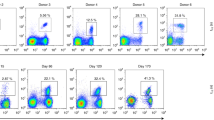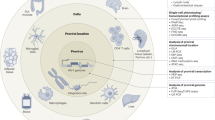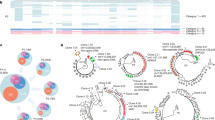Abstract
Within-patient HIV evolution reflects the strong selection pressure driving viral escape from cytotoxic T-lymphocyte (CTL) recognition. Whether this intrapatient accumulation of escape mutations translates into HIV evolution at the population level has not been evaluated. We studied over 300 patients drawn from the B- and C-clade epidemics, focusing on human leukocyte antigen (HLA) alleles HLA-B57 and HLA-B5801, which are associated with long-term HIV control and are therefore likely to exert strong selection pressure on the virus. The CTL response dominating acute infection in HLA-B57/5801-positive subjects drove positive selection of an escape mutation that reverted to wild-type after transmission to HLA-B57/5801-negative individuals. A second escape mutation within the epitope, by contrast, was maintained after transmission. These data show that the process of accumulation of escape mutations within HIV is not inevitable. Complex epitope- and residue-specific selection forces, including CTL-mediated positive selection pressure and virus-mediated purifying selection, operate in tandem to shape HIV evolution at the population level.
This is a preview of subscription content, access via your institution
Access options
Subscribe to this journal
Receive 12 print issues and online access
$209.00 per year
only $17.42 per issue
Buy this article
- Purchase on Springer Link
- Instant access to full article PDF
Prices may be subject to local taxes which are calculated during checkout



Similar content being viewed by others
References
Koenig, S. et al. Transfer of HIV-1-specific cytotoxic T lymphocytes to an AIDS patient leads to selection for mutant HIV variants and subsequent disease progression. Nat. Med. 1, 330–336 (1995).
Borrow, P. et al. Antiviral pressure exerted by HIV-1-specific cytotoxic T lymphocytes (CTLs) during primary infection demonstrated by rapid selection of CTL escape virus. Nat. Med. 3, 205–211 (1997).
Goulder, P.J. et al. Late escape from an immunodominant cytotoxic T-lymphocyte response associated with progression to AIDS. Nat. Med. 3, 212–217 (1997).
Barouch, D.H. et al. Eventual AIDS vaccine failure in a rhesus monkey by viral escape from cytotoxic T lymphocytes. Nature 415, 335–339 (2002).
Klenerman, P., Wu, Y. & Phillips, R. HIV: current opinion in escapology. Curr. Opin. Microbiol. 5, 408–413 (2002).
Evans, D.T. et al. Virus-specific cytotoxic T-lymphocyte responses select for amino-acid variation in simian immunodeficiency virus Env and Nef. Nat. Med. 5, 1270–1276 (1999).
Allen, T.M. et al. Tat-specific cytotoxic T lymphocytes select for SIV escape variants during resolution of primary viraemia. Nature 407, 386–390 (2000).
Phillips, R.E. et al. Human immunodeficiency virus genetic variation that can escape cytotoxic T cell recognition. Nature 354, 453–459 (1991).
Moore, C.B. et al. Evidence of HIV-1 adaptation to HLA-restricted immune responses at a population level. Science 296, 1439–1443 (2002).
Goulder, P.J. et al. Evolution and transmission of stable CTL escape mutations in HIV infection. Nature 412, 334–338 (2001).
Kaslow, R.A. et al. Influence of combinations of human major histocompatibility complex genes on the course of HIV-1 infection. Nat. Med. 2, 405–411 (1996).
Migueles, S.A. et al. HLA B*5701 is highly associated with restriction of virus replication in a subgroup of HIV-infected long term nonprogressors. Proc. Natl. Acad. Sci. USA 97, 2709–2714 (2000).
O'Brien, S.J., Gao, X. & Carrington, M. HLA and AIDS: a cautionary tale. Trends Mol. Med. 7, 379–381 (2001).
Goulder, P.J. et al. Novel, cross-restricted, conserved, and immunodominant cytotoxic T lymphocyte epitopes in slow progressors in HIV type 1 infection. AIDS Res. Hum. Retroviruses 12, 1691–1698 (1996).
Tang, J. et al. Favorable and unfavorable HLA class I alleles and haplotypes in Zambians predominantly infected with clade C human immunodeficiency virus type 1. J. Virol. 76, 8276–8284 (2002).
Yu, X.G. et al. Consistent patterns in the development and immunodominance of human immunodeficiency virus type 1 (HIV-1)-specific CD8+ T-cell responses following acute HIV-1 infection. J. Virol. 76, 8690–8701 (2002).
Novitsky, V. et al. Magnitude and frequency of cytotoxic T-lymphocyte responses: identification of immunodominant regions of human immunodeficiency virus type 1 subtype C. J. Virol. 76, 10155–10168 (2002).
Addo, M.M. et al. Comprehensive epitope analysis of human immunodeficiency virus type 1 (HIV-1)-specific T-cell responses directed against the entire expressed HIV-1 genome demonstrate broadly directed responses, but no correlation to viral load. J. Virol. 77, 2081–2092 (2003).
Altfeld, M.E.A. Influence of HLA-B57 on clinical presentation and viral control during acute HIV-1 infection. AIDS 17, 2581–2591 (2003).
Yang, Z. Maximum likelihood estimation on large phylogenies and analysis of adaptive evolution in human influenza virus A. J. Mol. Evol. 51, 423–432 (2000).
McMichael, A. & Klenerman, P. HIV/AIDS. HLA leaves its footprints on HIV. Science 296, 1410–1411 (2002).
Frahm, N. et al. Identification of highly immunodominant regions in HIV by comprehensive CTL screening of ethnically diverse populations. J. Virol. (in the press).
Barber, L.D. et al. Polymorphism in the α1 helix of the HLA-B heavy chain can have an overriding influence on peptide-binding specificity. J. Immunol. 158, 1660–1669 (1997).
Kelleher, A.D. et al. Clustered mutations in HIV-1 gag are consistently required for escape from HLA-B27-restricted cytotoxic T lymphocyte responses. J. Exp. Med. 193, 375–386 (2001).
Richman, D.D., Wrin, T., Little, S.J. & Petropoulos, C.J. Rapid evolution of the neutralizing antibody response to HIV type 1 infection. Proc. Natl. Acad. Sci. USA 100, 4144–4149 (2003).
Cohen, J. HIV. Escape artist par excellence. Science 299, 1505–1508 (2003).
Migueles, S.A. et al. The differential ability of HLA B*5701+ long-term nonprogressors and progressors to restrict human immunodeficiency virus replication is not caused by loss of recognition of autologous viral gag sequences. J. Virol. 77, 6889–6898 (2003).
Coffin, J.M. HIV population dynamics in vivo: implications for genetic variation, pathogenesis, and therapy. Science 267, 483–489 (1995).
Greene, W.C. & Peterlin, B.M. Charting HIV's remarkable voyage through the cell: basic science as a passport to future therapy. Nat. Med. 8, 673–680 (2002).
Novitsky, V. et al. Human immunodeficiency virus type 1 subtype C molecular phylogeny: consensus sequence for an AIDS vaccine design? J. Virol. 76, 5435–5451 (2002).
Singh, A.R., Hill, R.L. & Lingappa, J.R. Effect of mutations in Gag on assembly of immature human immunodeficiency virus type 1 capsids in a cell-free system. Virology 279, 257–270 (2001).
Furuta, R.A. et al. HIV-1 capsid mutants inhibit the replication of wild-type virus at both early and late infection phases. FEBS Lett. 415, 231–234 (1997).
Krogstad, P. et al. Human immunodeficiency virus nucleocapsid protein polymorphisms modulate the infectivity of RNA packaging mutants. Virology 294, 282–288 (2002).
Forshey, B.M., von Schwedler, U., Sundquist, W.I. & Aiken, C. Formation of a human immunodeficiency virus type 1 core of optimal stability is crucial for viral replication. J. Virol. 76, 5667–5677 (2002).
Braaten, D., Franke, E.K. & Luban, J. Cyclophilin A is required for the replication of group M human immunodeficiency virus type 1 (HIV-1) and simian immunodeficiency virus SIV(CPZ)GAB but not group O HIV-1 or other primate immunodeficiency viruses. J. Virol. 70, 4220–4227 (1996).
Braaten, D., Franke, E.K. & Luban, J. Cyclophilin A is required for an early step in the life cycle of human immunodeficiency virus type 1 before the initiation of reverse transcription. J. Virol. 70, 3551–3560 (1996).
Yoo, S. et al. Molecular recognition in the HIV-1 capsid/cyclophilin A complex. J. Mol. Biol. 269, 780–795 (1997).
Goulder, P.J. et al. Substantial differences in specificity of HIV-specific cytotoxic T cells in acute and chronic HIV infection. J. Exp. Med. 193, 181–194 (2001).
Bunce, M. et al. Phototyping: comprehensive DNA typing for HLA-A, B, C, DRB1, DRB3, DRB4, DRB5 & DQB1 by PCR with 144 primer mixes utilizing sequence-specific primers (PCR-SSP). Tissue Antigens 46, 355–367 (1995).
Goulder, P.J. et al. Rapid definition of five novel HLA-A*3002-restricted human immunodeficiency virus-specific cytotoxic T-lymphocyte epitopes by Elispot and intracellular cytokine staining assays. J. Virol. 75, 1339–1347 (2001).
Ross, H.A. & Rodrigo, A.G. Immune-mediated positive selection drives human immunodeficiency virus type 1 molecular variation and predicts disease duration. J. Virol. 76, 11715–11720 (2002).
Yang, Z. PAML: a program package for phylogenetic analysis by maximum likelihood. Comput. Appl. Biosci. 13, 555–556 (1997).
Swofford, D.L. in PAUP*. Phylogenetic Analysis Using Parsimony (* and other methods) 4th edn. (Sinauer Associates, Sunderland, Massachusetts, 2002).
Hayman, A. et al. Phylogenetic analysis of multiple heterosexual transmission events involving subtype B of HIV type 1. AIDS Res. Hum. Retroviruses 17, 689–695 (2001).
Kasper, P. et al. The genetic diversification of the HIV type 1 gag p17 gene in patients infected from a common source. AIDS Res. Hum. Retroviruses 11, 1197–1201 (1995).
Acknowledgements
We thank those who made possible the collection of blood samples for this study, in particular the staff at Cato Manor Clinic, Durban (the largest single cohort). We also thank M. Hammond and M. Bunce for HLA typing; C. Hull-Jackson, B. Matz, C. Edwards and H. Coovadia for facilitating these studies; M. Maiden and L. Richardson for assisting with the sequencing; and P. Klenerman and R. Phillips for critically reviewing the manuscript. This work was supported by the Wellcome Trust (P.J.R.G. and A.L.), the Elizabeth Glaser Pediatric AIDS Foundation (P.J.R.G. and M.F.), the Spanish Health Department (BEFI, Red G03/173 to J.M.-P.), the National Institutes of Health (AI46995-01A1 and N01-AI-15442) and the Doris Duke Charitable Foundation. P.J.R.G. is an Elizabeth Glaser Scientist and B.D.W. is a Doris Duke Distinguished Clinical Science Professor.
Author information
Authors and Affiliations
Corresponding author
Ethics declarations
Competing interests
The authors declare no competing financial interests.
Supplementary information
Rights and permissions
About this article
Cite this article
Leslie, A., Pfafferott, K., Chetty, P. et al. HIV evolution: CTL escape mutation and reversion after transmission. Nat Med 10, 282–289 (2004). https://doi.org/10.1038/nm992
Received:
Accepted:
Published:
Issue Date:
DOI: https://doi.org/10.1038/nm992
This article is cited by
-
Photoactive conjugated polymer-based strategy to effectively inactivate RNA viruses
NPG Asia Materials (2023)
-
Accumulation of mutations in antibody and CD8 T cell epitopes in a B cell depleted lymphoma patient with chronic SARS-CoV-2 infection
Nature Communications (2022)
-
Immune escape mutations in HIV-1 controllers in the Brazilian Amazon region
BMC Infectious Diseases (2020)
-
Prisoners of war — host adaptation and its constraints on virus evolution
Nature Reviews Microbiology (2019)
-
High polymorphism rates in well-known T cell epitopes restricted by protective HLA alleles during HIV infection are associated with rapid disease progression in early-infected MSM in China
Medical Microbiology and Immunology (2019)



